by Ed Bradley, Master Rosarian, San Antonio Rose Society
This is a 2020 AOM winner

Good Rosarians try to keep the foliage on their rose bushes green, clean and healthy. However, in spite of our best efforts, sometimes we experience a “yellowing” of leaves. Unfortunately, those yellow leaves usually drop from the bush, sometimes leaving the bush with an inadequate amount of leaves to produce plant food (via photosynthesis), thus reducing the vigor and vitality of the bush.
Yellow leaves on roses are not normal (even in the autumn). Leaves are supposed to be green. Yellow leaves should be immediately examined in an effort to determine why they are yellowing, then take the appropriate measures to correct the situation. Let’s take a quick look at some of the more common reasons for yellowing leaves.
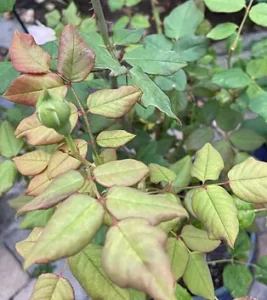
Drought: In the heat of our summer, probably the most common cause of yellow leaves is simply not enough water. An indication that drought stress is occurring is that the leaves have a weathered bronze-green color. We tend to under estimate the amount of water a rose bush needs, and we tend to over estimate the amount of water we give it. A healthy rose bush requires one-to-two inches of water each week during the hot summer. Even in the winter, or especially during the winter, we tend to let roses really dry out, unless we are getting good and regular rains, because we sometimes think the roses don’t require watering because it is cool. Not so. The one-to-two inches of water should be delivered in applications of 1/3 to ½ inch; in other words, you will be watering about every-other day. The use of a good mulch will enhance the effectiveness of your watering program.
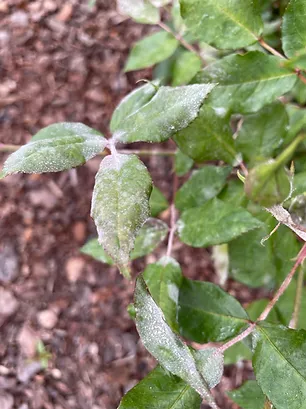
Fungus: The most common fungus here is blackspot; however, we can also be bothered by mildew. Almost everyone experiences blackspot in their garden, to some degree. Moisture on the leaves in early mornings will soften the leaf surface and activate blackspot spores. After the fungus spores penetrate the leaf surface, the black spots appear. The leaves will then turn yellow and drop off. An infected leaf is doomed. No matter what you spray with or how often you spray, the spotted leaf will not turn green again. There is a three-step solution: Remove as many of the infected leaves as possible, by hand. Spray weekly with a cleanup fungus-killer fungicide. Then spray with a preventive fungicide.
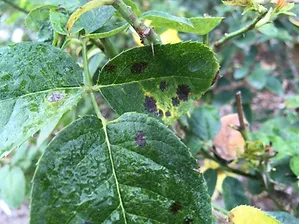
(The prevention fungicide (Honor Guard, Banner Max, Rose Pride – choose only one) and the fungus-killer fungicide (Manzate, Mancozeb, Pentathlon – choose only one) can be mixed and sprayed at the same time. If this regimen is followed, the fungus problem should be eliminated in two to four weeks. Remember, however, that prevention is the key, and a regular spraying program must be followed to preclude recurrence.
Spider Mites: These little devils can defoliate a rose bush in a week or so. They climb onto the bush from the ground, or from an adjoining bush which is infected. The lower leaves should be removed from the bush to make it a little more difficult for the spider mites to get a foothold. A high-pressure water-wash is most effective in removing the spider mites. If severely infected, washing needs to be done every third day for nine days. (Why three times? You won’t get all of them with one washing. Eggs already laid will hatch, and each subsequent washing will blast away the new mites.) Effective control has also been achieved using a spray mix of liquid seaweed and agricultural molasses (1 Tbsp each per gal. water). There are also some effective miticides available; however, they must be applied to the underside of the leaves where the mites live and reproduce. (Avid, Floramite, and Shuttle).
Too Much Water: Strangely enough, too much water exhibits almost the same characteristics as too little water – wilting and yellowing of leaves. Wet, soggy soil deprives the plant of sufficient oxygen, and the plant is actually suffocating. Make sure your soil drains well. That’s why we promote raised beds and use sand in our rose soil mix. Sometimes a good soil will become compacted by heavy rains, or the mulch may prevent water penetration to the root zone. Aerate your soil frequently with a spade fork, rake, or similar tool without damaging the root system.
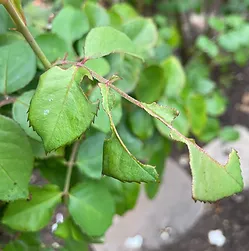

Damaged Leaves: Leaves that are broken, partially eaten by insects, or damaged by thorns on an adjacent cane will likely turn yellow and drop off. Some of this is normal, and there’s not much you can do about it. Obviously, you can kill the insects, and you can keep the extraneous growth cleaned out to minimize the damage from neighboring canes.
Dieback: Cane dieback is a mysterious disease which seems to defy explanation. There seems to be no common cause – fungus, bacteria, virus, whatever? The tip of the cane may simply begin to turn brown, and it will continue all the way to the origin of the cane (bud union). Other times, the entire cane will begin to turn yellow, followed by all leaves turning yellow, then the cane will turn brown (dead). When discovered, these should be immediately removed, all the way to the bud union.
Yellow leaves usually result from some kind of stress. Rosarians need to examine the circumstance to determine the cause, then take corrective actions to keep the bush green, clean and healthy. If you have an abundance of leaves dropping to the ground, keep these cleaned from under your bushes. They could very well harbor fungi or insects. Rake them away, or use your leaf blower to remove them. If you have difficulty determining the cause of yellow leaves on your bushes, call a Consulting Rosarian, or take samples to your local full-service nursery.
Finally, early autumn color on roses should be in the flowers – not the foliage.
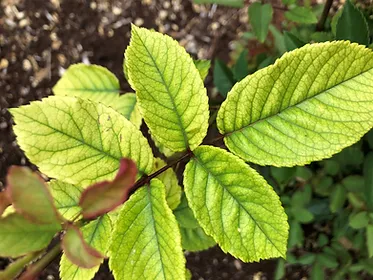
Nutritional Deficiencies
Remember that roses are heavy feeders. Healthy rose bushes produce an enormous amount of growth over the course of our 8 to 9 month growing season. As they bloom, we remove long stems, and they produce 2 or 3 more in their place. The removal and re-growth process occurs throughout the growing season. And, at the end, it is not unusual to have a bush 6 or 7 feet tall and 3 to 4 feet wide. And, when you realize that you have removed at least that much growth during the season, it is no wonder that they consume a huge amount of rose food.
Roses require a good, balanced fertilizer. That is, an ample amount of the major elements – Nitrogen (N), Phosphorous (P), and Potash (K), plus an available supply of the 17 trace elements. Deficiencies of N-P-K become readily apparent in the color and vigor of the bush. A deficiency in any of the trace elements may not be as immediately conspicuous, but will show up over time by discolored, distorted, dead or dying leaves.
A good soil mix, with plenty of organic material, normally contains an adequate amount of the trace elements. They are called “trace” or minor elements because only a very small amount is needed for normal plant growth. However, most quality fertilizer producers recognize the need for these trace elements, and the better fertilizers generally include a sufficient amount to sustain healthy growth. “Trace” elements are sort of like vitamins in our diet. Eating normally healthy foods generally gives us enough of the vitamins needed; however, if we have a special condition or as we grow older, it may be necessary to supplement our diet with certain vitamins. So it is with “trace” elements for plants.
Most cases of trace element deficiency are caused by some interference in the availability or uptake of these elements from the soil, rather than by an actual shortage of these nutrients in the soil. Poor aeration, over watering, root-knot nematodes, high levels of soluble salts, excessively high or low soil temperatures, and high or low pH may cause the trace elements to be unavailable to the plant.
Having said that, however, we all see spotted leaves, yellowing leaves, brown leaves and dropping leaves – and wonder “What’s going on in the garden?” So, let’s take a look at some of the common deficiencies and symptoms.
First, the N-P-K deficiencies:
Nitrogen: leaves show an overall yellow-green color, with random leaf spots. Older leaves may turn yellow and drop off. Flowers of darker varieties may appear several shades lighter than normal.
Phosphorous: stunting of leaves and stem growth, followed by older leaves losing their luster. They may become a gray-green and drop off without turning yellow. Some may show dark red or purple colors. Petals of pink flowers may become dark pink.
Potassium: stunted growth, shorter flower stems; small, short, deformed flower buds. Browning and dead tissue mainly at edges of leaves.
Now, let’s look at the trace element deficiencies:
Iron: areas between the veins of young leaves turn yellow, but veins remain a light green. There is generally an adequate amount of iron in the soil; however, because of the normally high pH of our soil, the iron is rendered unavailable. Therefore, the need to periodically add iron to our feeding program.
Calcium: young leaves are distorted, hooked or curled. Older leaves become a dull gray-green and may bend down at the edges. Later the edges may turn yellow, then brown with discolored blotches.
Boron: young leaves are light green at base, and twisted.
Copper: young leaves are permanently wilted with no chlorosis (yellowing).
Magnesium: yellowing starts from center of leaf, with signs of dying tissue.
Sulfur: leaves are light green with lighter green veins.
Zinc: large areas of dead tissue at tips and between veins.
Remedies can be very specific, such as Sprint 330 for iron or Epsom Salts for magnesium; however, a good application of a balanced fertilizer with trace elements will cure most unhealthy leaf problems caused by nutritional deficiencies. Lightly stir the soil for aeration, and add a good compost mulch to enhance the effectiveness of the fertilizer.




























































